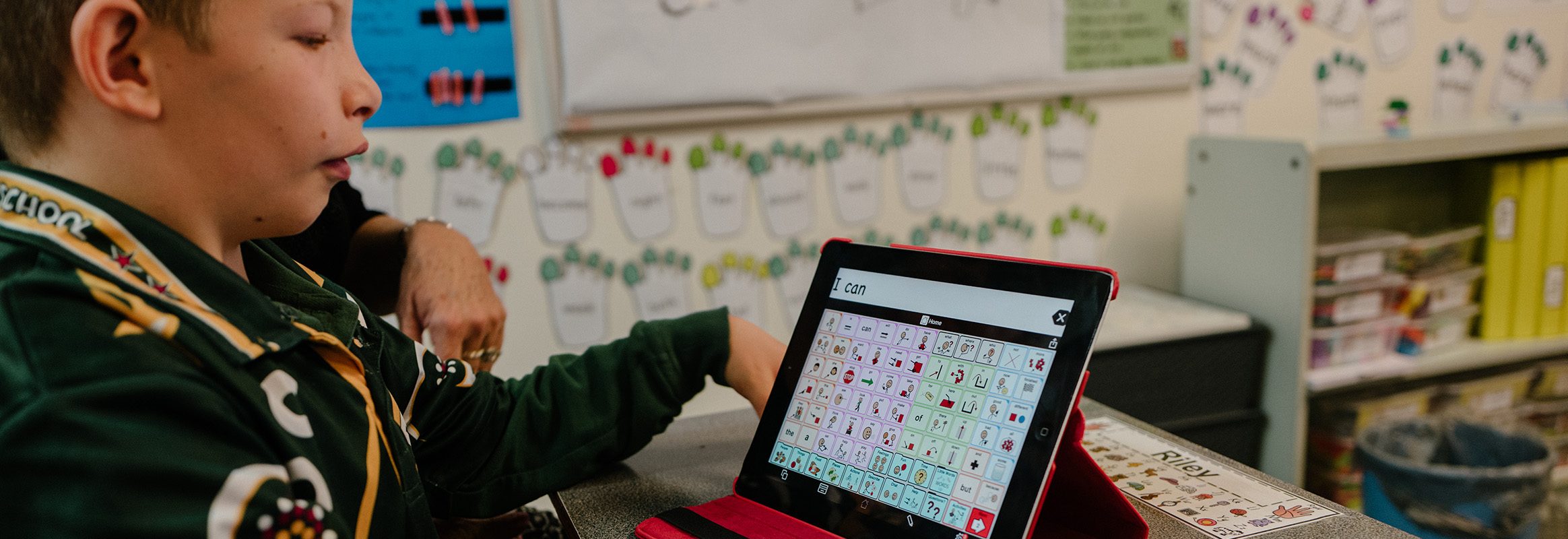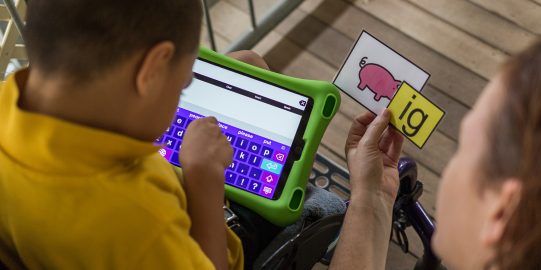Many people use Augmentative and Alternative Communication to say whatever they want to say. They combine words to make sentences. Language skills grow. Often we need to teach grammar.
To start, it is important to look at the AAC system. Is it a robust AAC system with access to core words, fringe vocabulary and the alphabet? Does the AAC system give access to different grammatical forms, including plurals, possessives and different verb tenses? Research shows that AAC users may have difficulty learning grammar. They cannot learn grammar, if their AAC system does not have grammatical forms available. Choose an AAC system that has access to many words and grammatical forms.
Modeling grammar
We model grammar. AAC users need to see how we might do it. So, teaching grammar happens when we point and show correct grammatical forms in sentences on the communication device.
When to start modeling grammar
We model words and sentences to match the language level of the AAC user. We may only model 1-2 words at first, before building up to longer word combinations. When an AAC user is communicating longer messages, it may be time to consider modeling specific grammar. There is no right or wrong way to teach grammar. Instead, it is best to follow the lead of the AAC user. Support them to get the grammar right in sentences they are already saying.
Teaching grammar can often be powerful alongside literacy instruction. We can observe different word and sentence structures in many texts. This can be a great way to integrate grammar teaching when using the AAC system.
Two key grammatical concepts
When considering grammar, there are two key things to teach our AAC user.
Sentence structure
We consider sentence structure. We use different word types in a particular order so the sentence makes sense. If a sentence is missing words or has words in the wrong order, it will not be grammatically correct. For example:
- “I go park” has little words left out.
- “cake I want” has words in the wrong order.
Teaching sentence structure can also include teaching an AAC user to use joining words (conjunctions) and connective phrases to construct longer messages.
Word structures
We look at specific word structures. This is how we learn to use the different grammatical forms of words in sentences. For example: we add different verb endings to reflect the tense of that verb, e.g. walk vs. walking vs. walked.
1. Modeling for sentence structure
When we first model for a beginning AAC user, we show the correct word order in sentences. We show what types of words can be combined together (e.g. pronoun-verb-noun).
When we model a sentence such as “I go park,” it may not be completely grammatically correct. However, it does show the correct word order in sentences.
A next step in this model, is to add or include the little words in the sentence. So now we could model “I go to park”, or even “I go to the park”.
Another step forward may be to add more words or join ideas. So then we could model “I go to the park and see bird”.
Another way to teach sentence structure is to provide a correct model of the AAC user's sentence as we respond to a message they have communicated. For example, if the AAC user says “cake I want,” we could respond by saying, “Oh, you are saying 'I want cake’, great, I want cake too!” (Model words on the AAC system as you speak.)
If the AAC user says “I go park,” we could respond by saying, “Cool, you said, ‘I go to the park,’ I am adding the little words to that sentence.” (Again, model words on the AAC system as you speak.)
Here is a simple list of different sentence structure elements that you can teach to AAC users:
- pronouns in sentences (e.g. he/ she/ they/ that/ you/ we/ it/ this etc.)
- articles in sentences (e.g. the/ a/ some)
- helper verbs in sentences (e.g. is/ are/ will/ was/ were)
- prepositional words in sentences (e.g. to/ with/ for/ in/ on)
- joining words in sentences (eg. and/ because/ but)
- forming questions with the correct word order (e.g. what/ when/ who/ where/ can/ do etc.)
2. Modeling for word structures
When the AAC user starts combining more words and forming more complex messages, it may be a good time to start modeling different word endings.
For example, we can model the correct grammatical forms when we tell news about our weekend, such as “I went to the park and saw birds.” In this sentence, we modeled the past tense verb “went” and the plural “s” in “birds.”
And another example, we can model other grammatical forms when we make plans, such as “We will get new shoes to go to Harry’s party.” In this sentence, we modeled the future tense verb “will get,” the plural “s” in “shoes” and the possessive “s” in “Harry’s party.”
Another way to teach word structures is to provide a correct model of their sentence as we respond to a message they have communicated. If the AAC user says “I go to the park,” we could respond by saying, “Cool! You said ‘I went to the park’ to tell me about your weekend. That sounds fun!” (Model words on the AAC system as you speak.)
Here is a simple list of word forms that you can teach to AAC users:
- Different pronoun forms: personal pronouns (he/ she), possessive pronouns (his/ her), etc.
- Past tense verb ending “-ed” (e.g. walked) or irregular forms of verbs (e.g. went)
- Present tense verb ending “-ing” (e.g. walking) or “-s” (eg. walks)
- Future tense verb forms including “will” (e.g. will walk)
- Negatives, eg. not walking, don't like
- Plural “-s” (e.g. birds), or “-es” (e.g. horses) or irregular forms of plurals (e.g. feet)
- Possessive “-’s” (e.g. Harry’s party)
- Comparative forms of adjectives using “-er” (eg. quicker) and irregular forms of comparatives (e.g. better)
- Superlative forms of adjectives using “-est” (eg. quickest) and irregular forms of superlatives (e.g. best)
Different communication functions
Having access to all these different grammatical forms and learning to use them means that AAC users will gain language to communicate for many different reasons.
Give a correct verbal model
When we are modelling on the AAC system, it is okay to use the AAC system while also verbally speaking the grammatically correct sentence. For example, I could model on my AAC system, “I go park see bird,” while verbally saying, “I went to the park and saw birds.”
Grammar in Proloquo2Go
The Crescendo™ vocabulary in Proloquo2Go contains support for grammatical development for AAC users. It does this by ensuring that all word kinds and grammatical forms are available.
Our Help and Support section contains information on finding words using the grammar support popups.
Teach grammar
Teaching grammar means that we are not only thinking about the AAC user’s language needs today, but also in the future. We can teach grammar when the AAC user is ready. Modeling grammar gives the AAC user every opportunity to learn how to combine words and use grammatical forms for full language.
Follow the links below for more strategies to build language and communication:
- Learn about core word teaching strategies
- Integrating specific literacy instruction
- Get practical ideas for building language
Go to the AssistiveWare Core Word Classroom to access many helpful planner documents. Each one includes a section on how you could teach specific grammar during that activity.
Links & References
- AAC Language Lab. Language Development Stages. [Website]
- Binger, C. & Light, J. (2008). The morphology and syntax of individuals who use AAC: research review and implications for effective practice. Augmentative and Alternative Communication, 24, 123-138.
- Ho, Kimberly. [2014]. AACtual Therapy: Supporting the development of early grammar with Kimberly Ho. [Blog post]
- Kent-Walsh, J. & Binger, C. (2009). Addressing the communication demands of the classroom for beginning communicators and early language users. In G. Soto & C. Zangari (Eds.), Practically speaking: Language, literacy and academic development for students with AAC needs (pp. 143–172). Baltimore, MD: Brookes.
- Light, J. C. & McNaughton, D. (2012). The changing face of augmentative and alternative communication: Past, present, and future challenges. Augmentative and Alternative Communication, 28, 197–204.
- Marden, Jennifer. Teach me to fish: Building grammar skills. [Blog post]
- Sutton, A., Soto, G. & Blockberger, S. (2002). Grammatical issues in graphic symbol communication. Augmentative and Alternative Communication, 18, 192–204.




